When facing a diagnosis of scoliosis, nearly everyone’s first thought is the same, “How can I treat this without surgery?” As a spine center that offers a multitude of surgical options, we ask this question, too. That’s because exhausting your conservative options before considering surgery gives your body the opportunity to respond to less invasive interventions.
It’s natural to seek conservative, non-invasive options, and fortunately, many effective methods exist to help manage scoliosis, reduce pain, and even slow curve progression. Chief among these scoliosis treatment options is the Schroth Method Therapy.
Schroth Method is a highly specific, three-dimensional (3D) physical therapy approach developed specifically for people with scoliosis (curved spines).
At The Advanced Spine Center in New Jersey, we believe in comprehensive care for scoliosis patients. This means we understand, utilize, and endorse effective non-surgical options like Schroth. Our expertise also allows us to be frank: for more advanced or highly progressive curves, sometimes conservative treatments will not be enough. For many, the precise moment when it’s time to move past conservative treatment like Schroth method for scoliosis and explore a surgical correction is sooner than expected.
What is Schroth Therapy for Scoliosis
Scoliosis is often simplified as a curve in the spine. However, it is a complex, three-dimensional condition that can involve more curvature types (as measured by the Cobb angle) than many think, specifically:
- Lateral Curve: The side-to-side curve you see on an X-ray.
- Kyphosis/Lordosis: The front-to-back curve.
- Axial Rotation: The twisting or rotation of the vertebrae, which causes the characteristic rib hump.
The Schroth Method, originating in Germany by Katharina Schroth in the 1920s, recognizes and addresses all three planes simultaneously. The core goal of Schroth is not just to stretch, but to teach the patient to actively de-rotate and stabilize their own spine, improving posture and preventing curve progression through highly customized Schroth exercises.
The 4 Pillars of the Schroth Exercise Method
Schroth Method is a specialized form of physical therapy or exercises for scoliosis built on four main pillars:
1. Autocorrection (Self-Elongation)
This is the concept of ‘untwisting’ and lengthening the spine. You actively pull your trunk out of its shortened, curved position. This conscious effort helps to centralize your body mass over your pelvis, which is the starting point for correcting spinal alignment.
2. Rotational Angular Breathing (RAB)
This unique breathing technique is essential for de-rotating the trunk. The therapist identifies the concave (flatter) side of your curve, the area where the ribs are compressed, and instructs you to breathe specifically into that area. This targeted expansion helps to reshape the rib cage and untwist the spine from the inside out.
3. Stabilization
Once you achieve a corrected posture through elongation and breathing, the next step is stabilization. This involves teaching specific muscle contractions to hold the corrected position. By practicing stabilization during Schroth exercises, you train your body to integrate that correction into daily life.
4. Postural Habits
The Schroth Method provides you with a set of “corrected” postures for sitting, standing, and walking. By consistently practicing these corrected habits, you reduce the strain on your spine and maximize the benefits achieved during therapy sessions.
Benefits of Schroth Method for Scoliosis Pain
When performed diligently and under medical supervision, the Schroth Method can provide significant benefits. The benefits include:
Pain Reduction: As stabilization and muscle balancing relieve the chronic strain often felt in the lower back and shoulders.
Improved Posture and Body Image: By actively untwisting and elongating the spine to reduce visible symptoms like uneven shoulders or prominent rib humps
Increased Lung Capacity: Through the mechanical impact of Rotational Angular Breathing;
Curve Stabilization: Which is highly effective for growing adolescents when combined with bracing to prevent further progression.
When Schroth Exercises Reaches Their Limit
While the Schroth Method is a valuable tool, it is important to be realistic about its capabilities. We encourage our patients to understand the difference between management and correction. Understanding all scoliosis treatment options is key to making an informed decision when it’s time to consider a surgery.
The key medical guideline for when surgery becomes the medically necessary treatment is based on the Cobb angle. If your curve progresses beyond a Cobb angle of 40° to 50°, and you are past the skeletal growth phase, or if the curve is rapidly progressing and threatening cardiopulmonary (heart and lung) function, non-surgical scoliosis treatments are no longer sufficient.
If non-surgical methods fail to stop scoliosis progression, or if the curve is severe enough to risk cardiopulmonary compromise, surgery is the only path to a definitive, permanent correction. Continuing with only conservative care like Schroth Therapy at this stage often leads to greater pain, disability, and a potentially more complex surgery later on.
Determining Your Best Path: A Surgical Consultation
Schroth Method is a valuable tool for management and stabilization, and it can significantly improve quality of life for many patients. However, understanding the limits of conservative care is the first step toward finding a lasting solution.
Beyond the medical questions, a surgical consultation also provides clarity on practical matters related to various scoliosis treatment options. Our experts can guide you, whether you are wondering about the best approach for mild scoliosis or assessing the need for definitive surgery.
Only a comprehensive evaluation by a surgical spine expert who understands all treatment options—both conservative and surgical—can provide an accurate prognosis and path forward. Don’t settle for management when permanent correction is possible. If you’ve been managing a curve above 40° to 50° (Cobb angle), it’s time for a definitive discussion. Contact The Advanced Spine Center today to schedule a surgical consultation and explore the path to a corrected spine.
